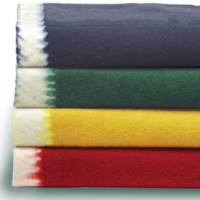|
 Broadcloth is a very old
fabric dating at least as far back as the Romans. Roman soldiers brought
it into England and a King of England later refined it into the smooth
soft fabric it is today. At one time it was not allowed to be exported
from England until it had gone through the process used by Flemish
weavers. These weavers were brought for the express purpose of this use of
careful steps in creating the fine fabric. The wool was processed, woven
into fabric and became very much in demand. This was as early as 1331 A.D. Broadcloth is a very old
fabric dating at least as far back as the Romans. Roman soldiers brought
it into England and a King of England later refined it into the smooth
soft fabric it is today. At one time it was not allowed to be exported
from England until it had gone through the process used by Flemish
weavers. These weavers were brought for the express purpose of this use of
careful steps in creating the fine fabric. The wool was processed, woven
into fabric and became very much in demand. This was as early as 1331 A.D.
The weaving process started
by the weavers producing the cloth, then the cloth was scoured in a trough
of water with a wooden scraper. The cleaned cloth was then stretched on
wooden racks to dry. These racks were known as tenters. The iron hooks
which held the cloth were known as the tenter-hooks. After drying the
cloth was rubbed over with fullers earth, which is found in the area. It
was then folded and hammered by a water powered heavy wooden hammer. This
gave the cloth a smooth surface. The cloth was then stretched again.
This high quality cloth was
in great demand and brought wealth to those English villages associated
with the industry.
In 1735 French traders in
America carried the “trade cloth” in canoes down the rivers from Canada at
great risk. Many were killed. These were the coureurs de risques' or “risk
takers.”
It is well documented as to
the trading of John Jacob Astor in his American Fur Company. Broadcloth,
or trade cloth was one of the materials he used to trade with the native
tribes.
Today, the fabric is very
expensive. Last time priced it was sixty dollars a yard, and may be more
by now. Because the Native Americans have used it for all these years one
can always recognize the skirts and the breechcloth of the men to be
coming from the fabric. This is usually ornately decorated with colorful
beadwork designs.
For the seamstress every
scrap is used in some way. There might be a man's tie, a small purse, or a
vest made from the remnants. These are tiny strips left from my mother's
sewing and this is what was done with them. Going around the pieces with a
zig zag sewing stitch binds the ends. A whip stitch around them out of a
bright colored yarn turns the tiny piece into a car key holder. Use a
large upholstery needle for the yarn. The eye will accommodate the heavier
thread.
See the Crazy Crow Trading Post |

